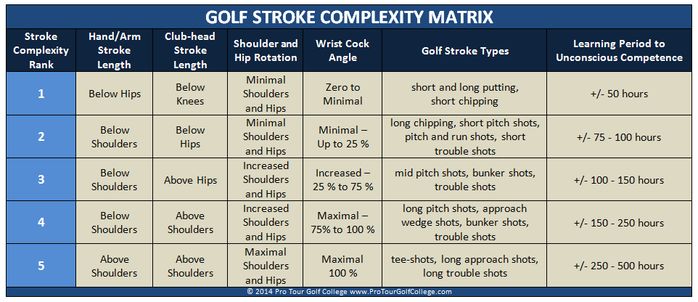5 Golf Improvement Hacks: How to Get Your Game Unstuck and Back On-Track Fast with Hack # 29/8/2014
“Any intelligent fool can make things bigger, more complex, and more violent. It takes a touch of genius — and a lot of courage to move in the opposite direction.” ― E.F. Schumacher  The pathway to continuous improvement in golf is long and demanding for most, and the reality is that the majority of those undertaking the journey will decide to set up camp along the way and never complete it. They will do this for a number of reasons and the most likely is that as their golf performances get closer to “old man par” they will need to acquire new skills and also develop and continually refine their existing skills to translate them into continuous improvement. This seems to be easier said than done. One of the most common mistakes we see advanced golfers make is that they quite often think that their current swing needs to be partially or even totally re-built, or changed if they are to keep travelling forwards on the path to golf success. In most cases we wouldn't agree with this approach. Like we say to our students at Pro Tour Golf College "there are many tragic stories of lost souls trapped in golf swing limbo whilst they traveled the path to golf swing perfection". Too often these golfers were actually performing really well and making progress but they determined (or someone helped them to determine) that in order to take their game to another level they required a major change. Quite often this change is another teacher and another golf swing method or style. Unfortunately this approach to change just makes playing golf a lot more challenging, and many of these golfers get very frustrated at their lack of progress and give up and do something else. Those that hang in there usually don’t make the level of progress they made prior to making the changes and they end up in a golf technique limbo. In today’s article we are going to share our 2nd golf improvement hack and our advice will help any golfer who is contemplating a change to their technique to understand the consequences of this decision and to approach it in a simpler and more manageable way.  Golf Improvement Hack Number 2: Reduce Skill Complexity to Increase Skill Competency The stroke that has the smallest number of rotations in the golf swing is the simplest stroke. The putting stroke is the simplest stroke in golf because you move your shoulders to move the putter and every other body part remains relatively still. The most complex golf stroke is the full swing. This stroke has the most rotations and requires almost supernatural timing to make it perform consistently. In between these two strokes are all the in-between strokes from the simple shorter strokes to the longer more complex ones. Think about this for a moment, you have thirteen major joints in your body rotating in 3 dimensional space, and you also have the timing of all these rotations to achieve a sound and consistent impact. The more rotations you employ in your golf stroke-the more challenging it is to produce consistency. This is the primary reason why amateur and professional golfers struggle to improve. It is fair to say that most golf instruction is focused on improving the most complex golf stroke—the full swing and the problem is not the ability of golfers to learn the stroke, it is the learning to forget "how to swing" that is the most challenging part of it. If you want to get out of your swing rut and improve your golf faster, then you need to learn and understand this hack; “Reduce Skill Complexity to Increase Skill Competency.” This hack say’s that continuous progress is made by reducing the complexity of the stroke pattern to decrease the time it takes to learn it, to get to the “forget how to do it” stage. Have a look at our Golf Stroke Complexity Matrix (below) to understand how as you increase stroke complexity you also increase the amount of hours it takes to move your stroke to the unconscious competence stage or the forget how to do it level.  Stroke Complexity Rank 1. These are strokes where you keep your hand stroke below your hips and the club-head arc travels below your knees in the back swing and forward swing phases. These are the putting and chipping strokes in golf and are the simplest strokes to learn and play. They require less hours to achieve the learning level of unconscious competence or the forget you know how to do it level and the rotations involved are a minimal amount of shoulder rotation for putting, and a minimal amount of hip and wrist rotation for chip shots.  Stroke Complexity Rank 2. These are strokes where you keep your hand stroke below your shoulders and your club-head travels no higher than your hips in the back swing and forward swing phase. These are your short pitch shots played around the green and require minimal shoulder rotation and hip rotation and wrist cock rotation. Because the rotations are minimal they are strokes that are considered easier to learn and habituate and the time required to learn skills like these range in 75 to 100 hours depending on the quality of your practice approach.  Stroke Complexity Rank 3. These are the strokes where the hand stroke is below your shoulders and the club-head arc travels no higher than your shoulders. These are long pitch strokes, short approach wedge shots and pitch shots from the rough and trouble lies. The increase in hand stroke length means that the shoulders and hips will start to rotate increasingly and the wrist cock rotation will be between 25 and 75 percent of its maximal amount. This stroke because it is travelling further is becoming a little more complex because of the increased rotations and it could take you anywhere from 100 to 150 hours of repetitions to habituate this stroke.  Stroke Complexity Rank 4. These are the strokes where the hand stroke is on or just below your shoulders and the club-head is now travelling well above your shoulders. The shoulder and hip rotation is almost maximal and the wrist cock angle will be between 75 and 100 percent. This type of stroke is used for most green-side bunker shots, most of your approach wedge shots, as also many of the recovery shots you will play from the tree's etc. This stroke is high on the complexity scale and requires anywhere from 150 to 250 hours of repetition practice to habituate this type of stroke.  Stroke Complexity Rank 5. These are golf strokes where the hand stroke is above your shoulders and the club-head is travelling well above and behind your shoulders for many golfers. This stroke is of course the stroke you use for tee-shots, long approach shots, fairway bunker shots and long trouble shots. It is the most complex of strokes to learn and requires enormous commitment because it is likely that to change any part of your stroke at this level will require from 250 to 500 hours of repetition practice. The rotations in the shoulders, hips and wrists are at maximal level and the forces that are generated are the highest. This is the stroke length many elite golfers continue to work on even when they reach tour level and quite often fail to realize the consequences of changing movement patterns at this level of complexity. So How Do You Simplify Your Stroke? First start by ranking your golf stroke change current level of complexity. Are you working at level 4 or 5 on the complexity scale? If you are, then discuss with your golf instructor if he/she thinks that you need reduce any of the rotations to reduce (or increase others) the complexity of the motion and improve the timing, moving you towards the unconscious competence stage of learning earlier. If you are stuck finding ways to make progress with your game you need to consider Hack # 2 carefully and realize that any work with a level 4 or higher complexity rank will require significant investment in these three elements: 1) ...A significant increase in the amount and quality of repetitions 2) ...A significant amount hours practicing the change/s 3) ...The time frame identified in the development plan to practice and develop your change/s outside of competing in tournaments There’s no doubt that if you can simplify your stroke you can repeat it more easily.  Take a good look at the technique you wish to improve with the assistance of your golf instructor and work out a plan for reducing the complexity in your stroke to increase your competency. Keep it simpler and you'll get there faster. See you next week for Golf Improvement Hack # 3. Lawrie Montague and David Milne - Pro Tour Golf College Your Success On Tour is Our Business Comments are closed.
|
Archives
June 2019
|
Proudly Supported By
Copyright © 2011 - 2018 Pro Tour Golf College
Website Managed By Golf Performance Media
All Rights Reserved
Website Managed By Golf Performance Media
All Rights Reserved



 RSS Feed
RSS Feed



